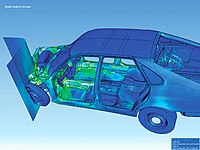
Photo from wikipedia
ABSTRACT Continuum crystal plasticity models based on the kinematics of plastic slip are widely developed and used in recent years to describe the anisotropic elasto-viscoplastic behaviour of metallic material. Various… Click to show full abstract
ABSTRACT Continuum crystal plasticity models based on the kinematics of plastic slip are widely developed and used in recent years to describe the anisotropic elasto-viscoplastic behaviour of metallic material. Various microstructural physical-based models have been proposed to reproduce experimental evolutions. This work aims to analyse and compare different crystal plasticity finite element models, especially those based on dislocation densities, from the simulations of stress–strain curves of a nickel base super alloy CMSX-4. Special attention is paid on hardening matrix. The adequacy between the simulated results and experimental data is commented, and it is found that a strain-rate- dependent double hardening matrix model can give a better prediction of the CMSX-4 behaviours.
Journal Title: Materials at High Temperatures
Year Published: 2020
Link to full text (if available)
Share on Social Media: Sign Up to like & get
recommendations!